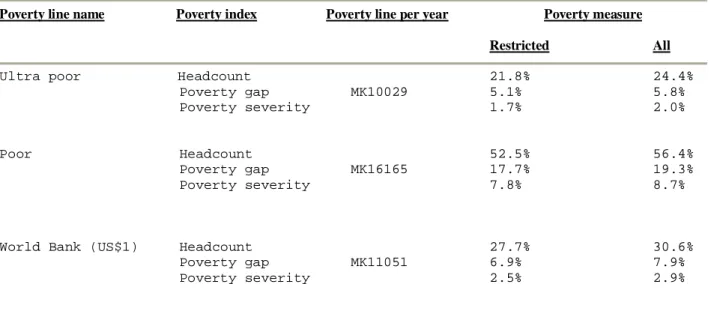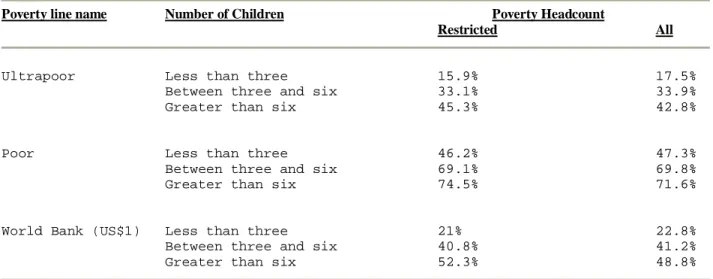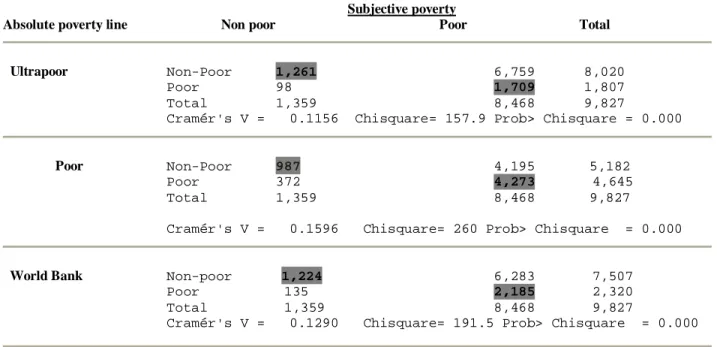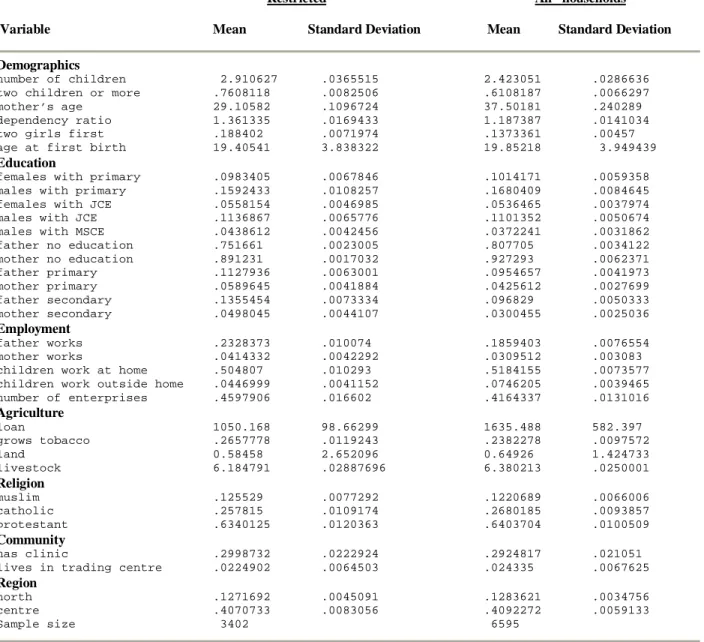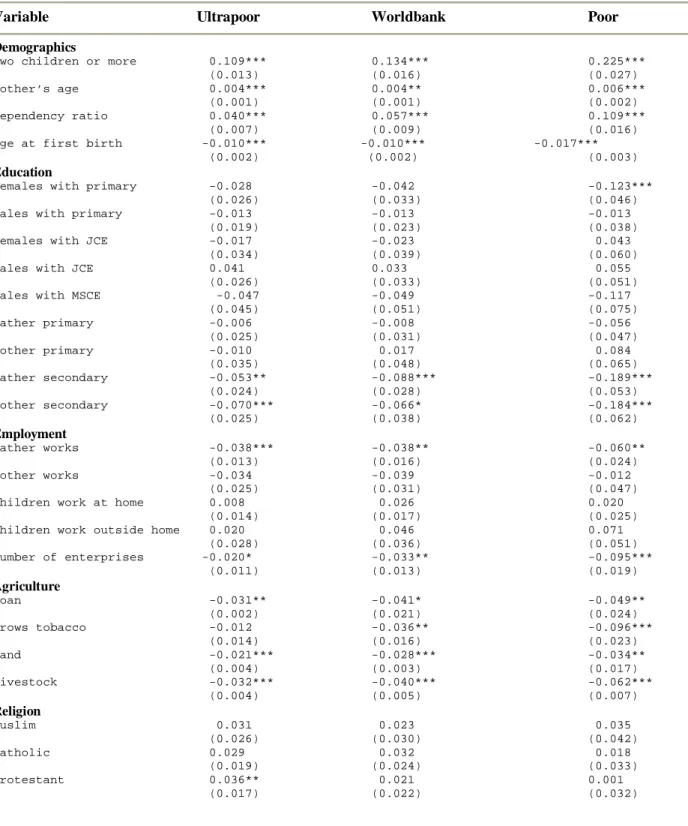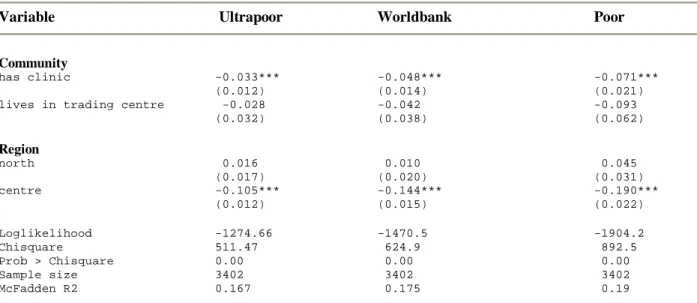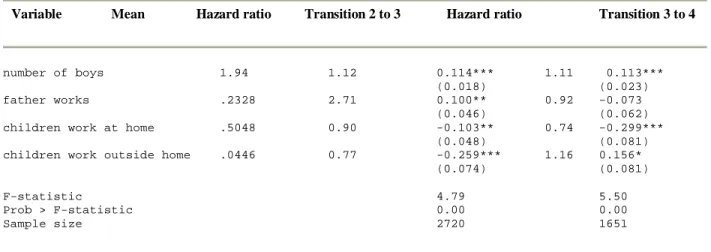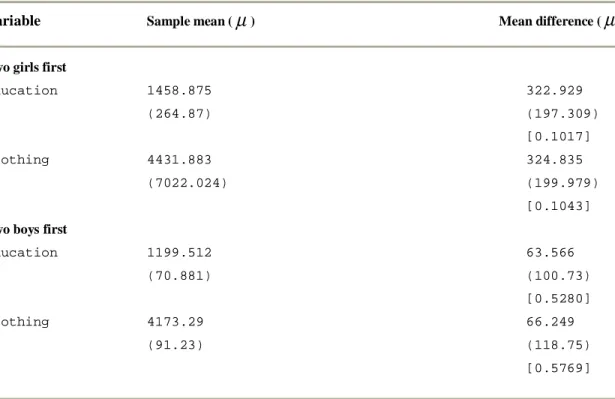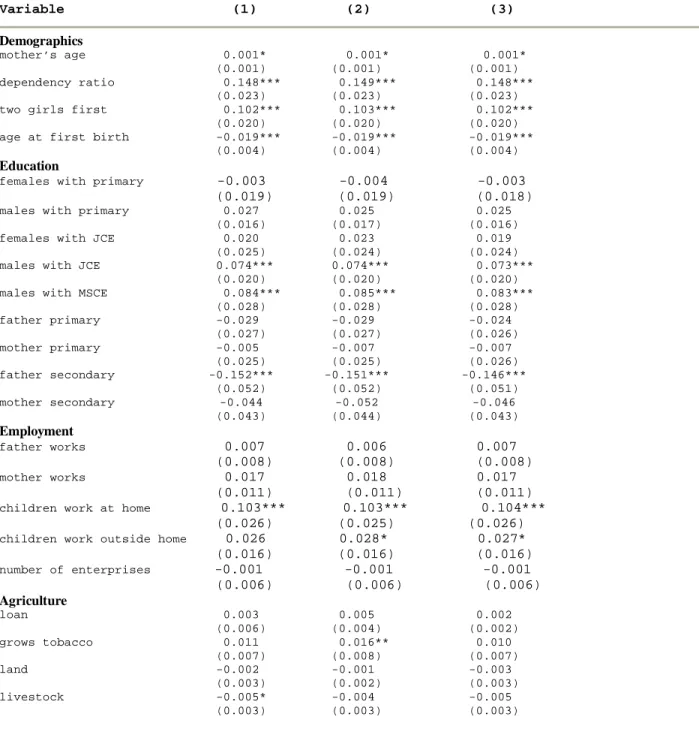Another shortcoming of these studies is that they only focused on poverty deposited in the objective monetary sense, which is a narrower definition of household welfare. In this section, we provide explanations given in the literature that show that causality between fertility and poverty is bidirectional. For example, the MIQ is phrased like "We would like you to tell us the absolute minimum income of money for a household like yours - in other words, an amount below which you could not make ends meet." The MIQ has been criticized for its focus on income, in that the concept of income can be poorly defined for respondents especially, but not only, in developing countries (Ravallion and Lokshin 2002).
To ... find out whether the effect of fertility on poverty is robust to the choice of poverty thresholds, we use three poverty thresholds, and look for the presence of sign reversals in the impact of fertility on the alternative poverty thresholds. The impact of fertility on subjective poverty is therefore modeled using the recursive bivariate probit presented in the preceding section for objective poverty.
Data and descriptives
This would mean that the limited sample we use for this study is an adequate representation of all rural households. This shows that the matching of households between the two definitions of poverty is weak. The results show that the restricted sample is generally not very different from the sample of all rural households; which suggests that it is a realistic depiction of rural households.
Impact of exogenous fertility on objective poverty
The impact is both statistically and economically significant, with magnitudes ranging from 1% to 9.6%. However, we note that for the lowest poverty line (ultra poor), the increase in smoking is not statistically significant…it cannot suggest that the increase in smoking has no statistically significant…it cannot have an effect on poverty at the bottom of bottom of the income distribution even though e¤ etc. seems to be economically large (about 1%). Surprisingly, land that is a productive resource statistically significantly increases the chance of being non-poor.
Controlling for endogenous fertility
For an accelerated failure time (AFT) model, if the hazard is higher for families with a son (or sons), the implication is that son preference is present. For the two transitions, the coefficient for the number of boys is positive and significant, suggesting the presence of son preference in rural Malawi16. Having established that son preference is present in rural Malawi, the next thing to do is to check if it is a valid instrument.
We … find that households with two girls … first have a significantly greater number of children with a mean difference (standard error) of. In Table 8, we report results of two sample t-tests of mean differences to check for evidence of the hand-me-down effect. If the hand-me-down effect is present, we would expect there to be a statistically significant difference in spending on clothing and education by gender of the child.
However, we do not have a statistically significant difference in spending on two voices between families with a preference for a son or two sons...first and those with one daughter and one son. The implication of this …conclusion is that son preference is not endogenous via the hand-me-down effect. Next we need to check the second condition that son preference and fertility are correlated.
Having two girls...first significant...increases the probability of having more than two children.
Impact of endogenous fertility on objective poverty
A father's education is a strong predictor of fertility, although mother's education does not have a significant effect on fertility. Since the con...dens intervals do not contain a zero, the cross-comparison error correlation (rho)20 results in Table 10 indicate that the null hypothesis of exogenous fertility is rejected at the 5% significance level for all poverty lines. It should be pointed out that the statistically significant effect of endogenous fertility is not consistent with a … determination by Gupta and Dubey (2006) for India.
They … find that the effect of fertility on poverty is statistically insignificant … after controlling for endogeneity. As expected, the dependent relationship is significantly and positively related to poverty across the three poverty lines. The recursive bivariate probit results show that having secondary education for mothers and fathers are statistically significant predictors of poverty.
As was the case with the univariate probit, most of the education variables have the expected negative sign, but they are not statistically significant... although they seem economically large. However, the effect appears to be economically significant, with the magnitude of the effects similar to those for fathers. Similar to the results from the simple probits ... we find that for the lowest poverty line (ultra-poor) tobacco cultivation has no statistically significant effect, although a marginal effect of about 1% would suggest that the e¤ect is economic substantial.
First, all the variables that were significant in the simple probit regressions are also significant after accounting for endogeneity.
Household composition and economies of scale
Second, the total effects for the joint estimation of fertility and poverty are generally larger than those for the univariate probit regressions. In the next section, we investigate whether or not our found impact of fertility on objective poverty is robust to taking into account household composition and economies of scale. For the parameter costs of children, our value is based on the value used by the World Bank for Zambia (2005).
For the univariate probit regression, the results indicate that the variables together are significant. As was the case with the poverty regressions per per capita, we find that for the adjusted regressions the effect of fertility across poverty lines increases as the poverty line increases, i.e. for the ultra-poor poverty line the reduction is about 83.4%, for the World Bank US$1 line the reduction is 77.6%, and … for the poor poverty line the reduction is 37.8%.
This implies that the higher the consumption, the lower the reduction in fertility impact after equivalent adult adjustments. After accounting for the endogeneity of fertility, as well as economies of scale and household composition, fertility significantly increases the likelihood of being poor along poverty lines. Furthermore, the impact is not as economically significant as that for the per capita models, as it ranges from 0.012 to 0.177, compared to a range of 0.139 to 0.304 for the unadjusted models.
For the ultra-poor model the reduction is 91.4%, for the World Bank's US$1 line the reduction is 77.8%, and … finally for the poor-poverty line the reduction is 35%.
Impact of fertility on continuous objective poverty
Our results are robust to the choice of poverty line and the impact of fertility across poverty lines increases as the poverty line increases, i.e. Compared to results from simple probit models that account for economies of scale and household composition, we observe that the impact of fertility on poverty is underestimated in simple probit models. The conclusion from these results is that accounting for economies of scale and household composition reduces the impact of fertility on poverty and that these reductions are economically large.
However, the effect of fertility is still statistically significant...whether or not fertility is exogenous or endogenous. So far, we have studied the effect of fertility on poverty, with poverty defined as a dummy. The impact of fertility on poverty is smaller if economies of scale and household composition are taken into account.
However, the impact of fertility on consumption is higher when we consider the endogeneity of fertility. The finding that accounting for endogeneity increases the impact of fertility on poverty is similar to the previous one, where poverty was defined as a dummy. Moreover, the impact of endogenous fertility is reduced when we consider economies of scale and household composition.
In the next section, we present the econometric results of the impact of fertility on subjective poverty, which is based on self-reported well-being.
Impact of fertility on subjective poverty
Specifically, given being widowed, separated, or divorced, polygamy reduces the odds of being subjectively poor by 7.6%, compared to 5.9% for monogamous households. To capture the income status of households, the level of annual real consumption per capita is also included. ...we find that household economic status, as measured by per capita consumption expenditure, reduces the likelihood of feeling poor by about 10%.
Sample selection bias
Two child versus one child families
In the paper, we sought to ... find the impact of fertility on poverty while recognizing the fact that the two variables are jointly determined. By using a natural experiment, son preference as our instrumental variable, we are able to use exogenous variation in the number of children to uncover the causal effect of fertility on poverty in rural households in Malawi. The positive effect of fertility on objective poverty is also found to hold when household composition and economies are taken into account, although the effect tends to be reduced.
Interestingly, fertility is found to be exogenous with respect to subjective poverty, which probably suggests that the endogeneity of fertility is a monetary phenomenon. This contradiction in the impact of fertility on the narrower objective poverty and the broader subjective poverty may be a possible explanation for why families in rural Malawi have many children (despite the fact that this makes them poor in an objective monetary sense) as it gets them to feel. less poor. Chernichovsky, D Socioeconomic correlates of fertility behavior in rural Botswana. An instrumental variable estimate of the effect of fertility on married women's labor force participation."
Yale University Center for Economic Growth Discussion Paper, No. Using Twins as a Natural Experiment", Econometrica, Vol 1984), Resources, Values and Development, Cambridge, MA: Harvard University Press. European Economic Review, Vol Constructing the poverty pro...le: An illustration of the importance of allowing for size and composition of the household in the case of Vietnam Coefficients are marginal effects estimated as fractional changes in the mean value of continuous covariates.
The total effect may not exactly equal the sum of the two effects due to rounding. For the bivariate probit poverty equations we report only the total marginal effects. For brevity, the total marginal effects of the fertility equation for the bivariate probit are not reported.
The dependent variables for the per capita models are a log of annualized real consumption expenditure per capita. The dependent variables for the AES regressions are the log of annualized real consumption expenditure per adult equivalent and the economies of scale.
